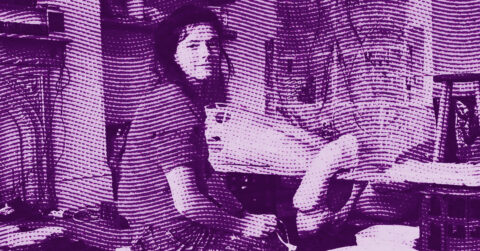Listen to me carefully, you bunch of snobs. There is, in today’s world, a silent invasion settling among us. Not that of algorithms watching us at every click, but that of an artist whose canvases reveal the core of our existence with disarming frankness. Zhang Zipiao, this Chinese painter born in 1993 in Beijing, presents us with the raw anatomy of our contemporaneity through her carnal abstractions.
In an artistic universe often dominated by the race for conceptual originality, Zhang Zipiao seizes the most traditional medium there is, oil painting, to create works that defy any simplistic classification. Neither completely abstract nor precisely figurative, her canvases inhabit this intermediate space where pictorial matter becomes flesh, where brushstrokes turn into pulsating organic fabrics.
When one observes a painting by Zhang Zipiao for the first time, one is immediately struck by the chromatic intensity. Bloody reds, fleshy pinks, deep purples intertwine in a visceral dance that simultaneously evokes life and death. Her compositions do not seek to please, but to provoke an instinctive, almost physical reaction. As she explains herself: “In my pictorial practice, I do not think inspiration arises from nowhere, but rather through assiduous creation, mixing colors and moving brushes; the constantly evolving imagery brings me a constant flow of new inspirations” [1].
This intuitive approach to creation recalls American Abstract Expressionism, but Zhang Zipiao infuses it with a sensitivity deeply rooted in her personal experience. Raised in a China undergoing profound transformation, she was exposed from a very young age to the medical images her mother, a doctor, brought home. These anatomical visions, these throats magnified in intense pink and red, left an indelible mark on her artistic imagination.
Zhang belongs to that generation of Chinese artists who grew up straddling two worlds: that of Chinese tradition and that of rampant globalization. Initially trained at the Maryland Institute College of Art and then at the School of the Art Institute of Chicago, she had the opportunity to confront directly the works that would nourish her artistic vision. The discovery of the painting “Figure with Meat” (1954) by Francis Bacon at the Modern Wing of Chicago was for her a revelation, a confirmation of the expressive power that the representation of flesh can have.
What distinguishes Zhang Zipiao from many other artists of her generation is her ability to divert subjects traditionally associated with beauty and delicacy to reveal their physical, almost brutal dimension. Her series “Floral Field”, “Peony”, “Lily” or “Calla Lily” are not mere representations of flowers, but explorations of the very texture of life. “I have always wanted to capture the texture of a petal,” she confides. “It is similar to human skin in its thickness, its moisture and its veins too, like an eyelid” [2].
This analogy between the plant and the human is not accidental. For Zhang, pomegranate seeds resemble kidneys or hearts inside the human body. The lines on the petals of flowers remind her of veins in human arms and legs, and the thick, moist petals evoke human flesh. This unified vision of the living forms the foundation of her artistic practice.
The corporeal dimension of her work reaches its peak in her series “Battlefield” (2021-2022), where the forms become almost entirely abstract, revealing only masses of flesh shaped by fluid curves. These monumental works, some measuring up to six meters wide, create a striking visual impact, as if the viewer were facing an organic battlefield where an inner struggle unfolds.
The issue of the female gaze on the body is central in Zhang Zipiao’s work. In a context where the female body has historically been objectified by the male gaze, her paintings offer a radically different perspective. Her female nudes, strongly deconstructed and abstracted, nevertheless retain a disturbing intimacy. The angle of representation, often very personal and private, gives the works a strong emotional charge while asserting the autonomy of the female subject in the face of the external gaze.
To fully understand the scope of Zhang Zipiao’s work, it is necessary to place it in the broader context of the aesthetics of violence, a concept developed by the philosopher Simone Weil. In her essay “Gravity and Grace,” Weil explores the complex relationship between beauty and violence, suggesting that true beauty lies not in superficial harmony, but in the honest confrontation with the brutality of reality. “Beauty captivates the flesh in order to obtain permission to pass through to the soul,” she writes [3]. Zhang Zipiao’s paintings embody this tension between beauty and violence. Her compositions, of strange and disturbing beauty, force us to face what we would often prefer to ignore: the fragility of our bodily existence, the permeability between life and death, the violence inherent in the very process of life.
The influence of digital art and the visual cultures of social networks is also perceptible in her work. Her contrasting palettes and graphic lines distinctly reflect the influence of digital images and screens. This contemporary dimension anchors her work in our time while allowing it to dialogue with pictorial tradition.
The COVID-19 pandemic marked a turning point in Zhang Zipiao’s practice. During the three long years of China’s isolation from the rest of the world, the artist developed a new approach, more instinctive, approaching the canvas without a preset plan, with raw emotion and pure energy. This process constitutes her response to the uncertainty experienced during this tumultuous period, both on a personal and collective level.
In her series “Mother of Pearl” (2023), presented during her exhibition “Swallow Whole” at the LGDR gallery in New York, Zhang explores the powerful symbolism of oysters and pearls. The monumental diptych “Mother of Pearl 08” (2023), which extends over four meters wide, presents a deconstructed oyster surrounded by swirling lines undulating like crashing waves of color. This work evokes Botticelli’s “The Birth of Venus,” but here, the goddess of love is absent, leaving us facing the empty shell, an ambiguous symbol of fertility and emptiness.
The “Moonquake” exhibition at the Long Museum West Bund in 2022 marked her first institutional solo exhibition in mainland China. The title refers to the tremors that occur beneath the seemingly calm surface of the moon, a metaphor for the complex mental conditions of contemporaries, the richness of feminine emotions, and the link between the act of painting and the depth of human consciousness.
The sexual dimension is never far from Zhang Zipiao’s work, but it is treated with a subtlety that defies expectations. Her works evoke Georgia O’Keeffe and Louise Bourgeois, with their inherent Freudian analyses, but Zhang attributes her fascination with spiders and oysters to the long nights spent in the depths of social media rather than art history. “In the middle of the night, one of these videos appears, showing someone extracting pearls from the flesh of shells,” she explains. “It’s almost like Dr. Pimple Popper, the way the pearls come out. Everything is so spongy. I couldn’t help but watch these videos and thought ‘I am going to paint that'” [4].
This anecdote reveals a lot about her creative process. Zhang Zipiao works without preparatory drawings, without live models or reference photos, preferring to rely on her imagination and memory. She begins by boldly scribbling on a blank canvas, letting lines, shapes, and contours guide her to the next step. This approach is reminiscent of the attitude of abstract expressionists, for whom emotion was the primary force filling the canvas.
Art critic Katie White rightly observed that Zhang “draws on a sense of isolation, escape, voyeuristic pleasure, and perversity that permeate our daily lives. Order barely holds; we are flooded by her entanglements of ribbon-like paintings, which accumulate, ready to topple and scatter. The opulence of it all could be our downfall.”
This opulence, this almost excessive richness of pictorial material and symbolic references, is indeed characteristic of Zhang Zipiao’s work. It recalls still lifes, vanitas of the Western tradition, those sumptuous representations of food that served as symbols of moral decay and reminders of the ephemerality of the soul.
The use of red in Zhang’s work is particularly interesting. For her, reds, pinks, and purples constitute a kind of grayscale in her work, a register of the basic colors of flesh, which she modulates up or down. “Red is a color that can be both very good and very bad. It can be a warning; red can tell you to stop. It symbolizes passion, vitality, but also blood,” she says. “It is an extreme color, and I wouldn’t say that I personally like it.”
This ambivalence toward her dominant color perfectly reflects the tension that runs throughout her work: between seduction and repulsion, between pleasure and pain, between life and death. Zhang Zipiao presents us with an art that refuses complacency and demands from us an honest confrontation with our condition as beings of flesh.
What makes the strength of Zhang Zipiao’s work is her ability to make us physically feel what we see. Her paintings are not simply to be looked at; they are to be experienced. They remind us that the most powerful art is not the one that comforts us in our certainties, but the one that disturbs us, shakes us up, and ultimately transforms us.
In a contemporary art world often dominated by conceptual and digital art, Zhang Zipiao strongly reaffirms the relevance and power of painting as a medium capable of connecting us to our most fundamental humanity. Through her fleshy abstractions, she invites us to an authentic, visceral experience that transcends cultural boundaries and reminds us of our shared condition.
- Quotation from Zhang Zipiao about her painting practice, taken from the official website of the Lévy Gorvy Dayan gallery, 2023.
- Comments collected by Katie White during an interview with the artist for Artnet News, June 2023.
- Weil, Simone. “Gravity and Grace”, Plon, 1947.
- Interview with Katie White for Artnet News, “Beijing-Based Painter Zhang Zipiao Abstracts the Bounty of Life, Flesh, Flowers, Fruit, in Her Opulent Still Lifes”, June 2023.
















